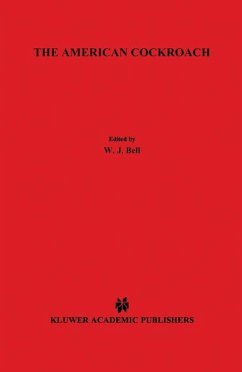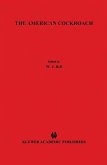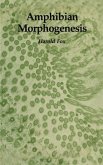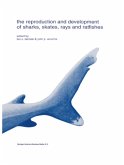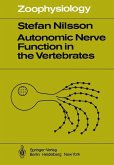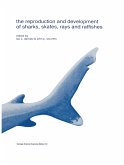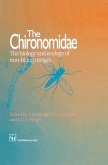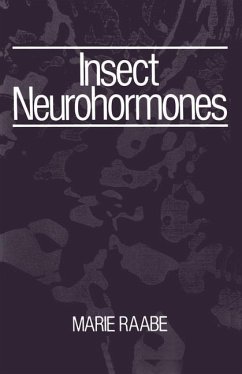K.G. Adiyodi
The American Cockroach
K.G. Adiyodi
The American Cockroach
- Broschiertes Buch
- Merkliste
- Auf die Merkliste
- Bewerten Bewerten
- Teilen
- Produkt teilen
- Produkterinnerung
- Produkterinnerung
This volume deals mainly with the biology of the American cockroach, Periplaneta americana (1.). Contributors were urged to emphasize recent findings, including unpublished data when possible, a goal that would not have been feasible if it were not for the two previously published books on the basic biology of cockroaches, The Biology o/the Cockroach (1968) by D. M. Guthrie and A. R. Tindall and The Cockroach, Volume 1 (1968) by P. B. Cornwell. Those topics not included in The American Cockroach, such as external morphology, are well covered in the two preceding books. In addition, these books…mehr
Andere Kunden interessierten sich auch für
![The American Cockroach The American Cockroach]() K.G. AdiyodiThe American Cockroach242,99 €
K.G. AdiyodiThe American Cockroach242,99 €![Amphibian Morphogenesis Amphibian Morphogenesis]() Harold FoxAmphibian Morphogenesis81,99 €
Harold FoxAmphibian Morphogenesis81,99 €![The reproduction and development of sharks, skates, rays and ratfishes The reproduction and development of sharks, skates, rays and ratfishes]() DemskiThe reproduction and development of sharks, skates, rays and ratfishes161,99 €
DemskiThe reproduction and development of sharks, skates, rays and ratfishes161,99 €![Autonomic Nerve Function in the Vertebrates Autonomic Nerve Function in the Vertebrates]() S. NilssonAutonomic Nerve Function in the Vertebrates81,99 €
S. NilssonAutonomic Nerve Function in the Vertebrates81,99 €![The reproduction and development of sharks, skates, rays and ratfishes The reproduction and development of sharks, skates, rays and ratfishes]() The reproduction and development of sharks, skates, rays and ratfishes161,99 €
The reproduction and development of sharks, skates, rays and ratfishes161,99 €![The Chironomidae The Chironomidae]() P.D. Armitage / L.C. Pinder / P.S. Cranston (Hgg.)The Chironomidae403,99 €
P.D. Armitage / L.C. Pinder / P.S. Cranston (Hgg.)The Chironomidae403,99 €![Insect Neurohormones Insect Neurohormones]() Marie RaabeInsect Neurohormones41,99 €
Marie RaabeInsect Neurohormones41,99 €-
-
-
This volume deals mainly with the biology of the American cockroach, Periplaneta americana (1.). Contributors were urged to emphasize recent findings, including unpublished data when possible, a goal that would not have been feasible if it were not for the two previously published books on the basic biology of cockroaches, The Biology o/the Cockroach (1968) by D. M. Guthrie and A. R. Tindall and The Cockroach, Volume 1 (1968) by P. B. Cornwell. Those topics not included in The American Cockroach, such as external morphology, are well covered in the two preceding books. In addition, these books provided a broad background upon which contributors to The American Cockroach have been able to build with recent trends, new and established concepts and integration. Although this book deals primarily with the American cockroach, many chapters offer a comparative approach in sections where the more recent and exciting research has been accomplished on other species. Most contributors place the cockroach in perspective with regard to its appropriateness or inappropriateness for various types of biological investigations. Many questions are realistically left unanswered when no acceptable or obvious solution is apparent; an invitation to new researchers to consider the cockroach as an experimental subject.
Hinweis: Dieser Artikel kann nur an eine deutsche Lieferadresse ausgeliefert werden.
Hinweis: Dieser Artikel kann nur an eine deutsche Lieferadresse ausgeliefert werden.
Produktdetails
- Produktdetails
- Verlag: Springer / Springer Netherlands
- Artikelnr. des Verlages: 978-94-009-5829-6
- 1981
- Seitenzahl: 552
- Erscheinungstermin: 19. Oktober 2011
- Englisch
- Abmessung: 235mm x 155mm x 30mm
- Gewicht: 826g
- ISBN-13: 9789400958296
- ISBN-10: 9400958293
- Artikelnr.: 39495655
- Herstellerkennzeichnung Die Herstellerinformationen sind derzeit nicht verfügbar.
- Verlag: Springer / Springer Netherlands
- Artikelnr. des Verlages: 978-94-009-5829-6
- 1981
- Seitenzahl: 552
- Erscheinungstermin: 19. Oktober 2011
- Englisch
- Abmessung: 235mm x 155mm x 30mm
- Gewicht: 826g
- ISBN-13: 9789400958296
- ISBN-10: 9400958293
- Artikelnr.: 39495655
- Herstellerkennzeichnung Die Herstellerinformationen sind derzeit nicht verfügbar.
1. Introduction.- 1.1 Distribution.- 1.2 Life cycle.- 1.3 Ecology.- 1.4 Biotic associations and medical importance.- 1.5 Economic and biological importance.- 2. Integument.- 2.1 Introduction.- 2.2 Structure of the integument.- 2.3 Integument during ecdysis.- 2.4 Stabilization of the oötheca.- 3. Circulatory System.- 3.1 Introduction.- 3.2 Heart and circulation.- 3.3 Haemolymph volume.- 3.4 Haemocytes.- 3.5 Constituents of haemolymph.- 4. Nutrition and Digestion.- 4.1 Introduction.- 4.2 Morphology of the alimentary canal and salivary glands.- 4.3 Nutrition.- 4.4 Enzymology.- 4.5 Physiology of digestion.- 4.6 Microbiology and pathology of the gut.- 5. Respiration.- 5.1 Introduction.- 5.2 Rates of gaseous exchange.- 5.3 Morphology of the tracheal system.- 5.4 Spiracle activity.- 5.5 Ventilation mechanisms.- 5.6 Diffusive-convective gas exchange in quiescent insects.- 6. Osmoregulation and Excretion.- 6.1 Introduction.- 6.2 Water relations.- 6.3 Components of water and ion metabolism.- 6.4 Excretory products.- 6.5 Regulation and kinetics of osmoregulation.- 6.6 Conclusions.- 7. Fat Body and Metabolism.- 7.1 Introduction.- 7.2 Morphology.- 7.3 Histology and ultrastructure.- 7.4 Bacteroids.- 7.5 Composition of fat body.- 7.6 Intermediary metabolism.- 7.7 Conclusions.- 8. Nervous System.- 8.1 Introduction.- 8.2 Structural organization of central and peripheral pathways.- 8.3 The extraneuronal compartment.- 8.4 Electrophysiology.- 8.5 Synaptic transmission.- 8.6 Toxicology.- 8.7 Functional organization.- 8.8 Learning.- 9. Sense Organs.- 9.1 Introduction.- 9.2 Visual system.- 9.3 Mechanoreceptive sensory systems.- 9.4 Antennal sensory system.- 9.5 Chemoreceptors on the maxillary palpus.- 9.6 Conclusions.- 10. Rhythms.- 10.1 Concepts and terminology.- 10.2 Circadian rhythms ofindividuals.- 10.3 Circadian rhythms of populations.- 10.4 Circadian rhythms of physiological systems.- 10.5 Location of photoreceptors and circadian pacemakers.- 10.6 Rhythms other than circadian.- 10.7 Conclusions.- 11. Muscles and Muscular Activity.- 11.1 Introduction.- 11.2 Organization and innervation.- 11.3 Biochemistry.- 11.4 Electrophysiology.- 11.5 Neuromuscular transmission and its chemical basis.- 11.6 Mechanical properties.- 11.7 Functional use of muscle.- 12. Neurosecretions and Hormones.- 12.1 Introduction.- 12.2 Neurosecretory cells (NSC).- 12.3 Corpora cardiaca (CC).- 12.4 Neurohormones of the ventral nerve cord.- 12.5 Corpora allata (CA).- 12.6 Prothoracic glands (PG).- 12.7 Ovary as an endocrine organ.- 13. Reproduction.- 13.1 Introduction.- 13.2 Female reproductive system.- 13.3 Male reproductive system.- 14. Pheromones and Behaviour.- 14.1 Introduction.- 14.2 Orientation.- 14.3 Courtship.- 14.4 Agonism.- 14.5 Aggregation.- 14.6 Learning.- 14.7 Conclusion.- 15. Embryonic and Post-Embryonic Development.- 15.1 Introduction.- 15.2 Embryogenesis.- 15.3 The ootheca.- 15.4 Culture of intact embryos ex-ovo.- 15.5 Embryonic behaviour development.- 15.6 Eclosion and hatching.- 15.7 Tissue culture of the embryonic nervous system.- 15.8 Conclusion.- 16. Regeneration.- 16.1 Introduction.- 16.2 Tissues with regenerative potential.- 16.3 Phenomenology of limb regeneration.- 16.4 Regulation of regeneration.- 16.5 Unified model.- 16.6 Conclusion.- References.- Species Index.'1. Introduction.- 1.1 Distribution.- 1.2 Life cycle.- 1.3 Ecology.- 1.4 Biotic associations and medical importance.- 1.5 Economic and biological importance.- 2. Integument.- 2.1 Introduction.- 2.2 Structure of the integument.- 2.2.1 Macromolecular structure.- 2.2.2 Chemical composition of the cuticle.- 2.3.3 Supermolecular structure of the cuticle.- 2.3 Integument during ecdysis.- 2.3.1 Post-ecdysial changes in the cuticle.- 2.3.2 Bursicon-mediated control of cuticle sclerotization.- 2.3.3 Accumulative control mechanisms associated with ecdysis.- 2.4 Stabilization of the oötheca.- 3. Circulatory System.- 3.1 Introduction.- 3.2 Heart and circulation.- 3.3 Haemolymph volume.- 3.4 Haemocytes.- 3.5 Constituents of haemolymph.- 3.5.1 Ionic composition.- 3.5.2 Haemolymph sugars: trehalose and glucose.- 3.5.3 Haemolymph lipids.- 3.5.4 Haemolymph proteins.- 4. Nutrition and Digestion.- 4.1 Introduction.- 4.2 Morphology of the alimentary canal and salivary glands.- 4.2.1 General organization.- 4.2.2 Microscopy.- 4.2.3 The peritrophic membrane.- 4.2.4 Innervation.- 4.3 Nutrition.- 4.3.1 Natural and synthetic diets.- 4.3.2 Specific requirements.- 4.3.3 Long-term regulation of intake.- 4.4 Enzymology.- 4.4.1 pH and redox potentials.- 4.4.2 Digestive enzymes.- 4.4.3 Control of secretion.- 4.5 Physiology of digestion.- 4.5.1 Gut movements.- 4.5.2 Absorption of inorganic ions and water.- 4.5.3 Absorption of organic materials.- 4.6 Microbiology and pathology of the gut.- 5. Respiration.- 5.1 Introduction.- 5.2 Rates of gaseous exchange.- 5.3 Morphology of the tracheal system.- 5.3.1 The tracheal plan.- 5.3.2 Fine structure.- 5.3.3 Non-respiratory functions of the tracheal system.- 5.3.4 Spiracle structure.- 5.3.5 Spiracle innervation.- 5.4 Spiracle activity.- 5.4.1 Independent spiracle action.- 5.4.2 Segmental control.- 5.4.3 Intersegmental control.- 5.5 Ventilation mechanisms.- 5.5.1 The organization of pumping movements.- 5.5.2 Ventilation in quiescent insects.- 5.5.3 Ventilation in active and in stressed insects.- 5.5.4 Auxiliary ventilation and autoventilation.- 5.5.5 Spiracle activity coupled to ventilation.- 5.5.6 Non-respiratory functions of spiracle coupling.- 5.5.7 The origin and control of the ventilatory rhythm.- 5.5.8 Sensory co-ordination of ventilation.- 5.6 Diffusive-convective gas exchange in quiescent insects.- 5.6.1 Saturniid pupae.- 5.6.2 Periplaneta americana.- 5.6.3 The endogenous patterning of intermittent ventilation.- 5.6.4 One-muscle spiracles and diffusive-convective gas exchange.- 6. Osmoregulation and Excretion.- 6.1 Introduction.- 6.1.1 General comments and reference to previous treatments of osmoregulation and excretion in cockroaches and other insects.- 6.1.2 Basic concepts in osmoregulation and excretion.- 6.2 Water relations.- 6.2.1 Water content.- 6.2.2 Water loss.- 6.2.3 Tolerance to stress.- 6.3 Components of water and ion metabolism.- 6.3.1 Sources.- 6.3.2 Pools and structures involved in osmoregulation and excretion.- 6.4 Excretory products.- 6.4.1 Nitrogenous excretory products.- 6.4.2 Miscellaneous materials.- 6.5 Regulation and kinetics of osmoregulation.- 6.5.1 Regulation of ionic composition.- 6.5.2 Hormonal influences and kinetics of ion transport.- 6.5.3 Energetics of excretion.- 6.6 Conclusions.- 7. Fat Body and Metabolism.- 7.1 Introduction.- 7.2 Morphology.- 7.3 Histology and ultrastructure.- 7.3.1 Trophocytes.- 7.3.2 Urate cells.- 7.3.3 Mycetocytes.- 7.4 Bacteroids.- 7.4.1 General description.- 7.4.2 Functional significance.- 7.4.3 Culture of bacteroids.- 7.5 Composition of fat body.- 7.5.1 Organic constituents.- 7.5.2 Inorganic constituents.- 7.6 Intermediary metabolism.- 7.6.1 Synthesis of glycogen and trehalose.- 7.6.2 Gluconeogenesis.- 7.6.3 Synthesis of lipids.- 7.6.4 Protein synthesis.- 7.6.5 Uric acid metabolism.- 7.6.6 Amino acid metabolism.- 7.6.7 Glycogenolysis.- 7.6.8 Glycolysis and th
1. Introduction.- 1.1 Distribution.- 1.2 Life cycle.- 1.3 Ecology.- 1.4 Biotic associations and medical importance.- 1.5 Economic and biological importance.- 2. Integument.- 2.1 Introduction.- 2.2 Structure of the integument.- 2.3 Integument during ecdysis.- 2.4 Stabilization of the oötheca.- 3. Circulatory System.- 3.1 Introduction.- 3.2 Heart and circulation.- 3.3 Haemolymph volume.- 3.4 Haemocytes.- 3.5 Constituents of haemolymph.- 4. Nutrition and Digestion.- 4.1 Introduction.- 4.2 Morphology of the alimentary canal and salivary glands.- 4.3 Nutrition.- 4.4 Enzymology.- 4.5 Physiology of digestion.- 4.6 Microbiology and pathology of the gut.- 5. Respiration.- 5.1 Introduction.- 5.2 Rates of gaseous exchange.- 5.3 Morphology of the tracheal system.- 5.4 Spiracle activity.- 5.5 Ventilation mechanisms.- 5.6 Diffusive-convective gas exchange in quiescent insects.- 6. Osmoregulation and Excretion.- 6.1 Introduction.- 6.2 Water relations.- 6.3 Components of water and ion metabolism.- 6.4 Excretory products.- 6.5 Regulation and kinetics of osmoregulation.- 6.6 Conclusions.- 7. Fat Body and Metabolism.- 7.1 Introduction.- 7.2 Morphology.- 7.3 Histology and ultrastructure.- 7.4 Bacteroids.- 7.5 Composition of fat body.- 7.6 Intermediary metabolism.- 7.7 Conclusions.- 8. Nervous System.- 8.1 Introduction.- 8.2 Structural organization of central and peripheral pathways.- 8.3 The extraneuronal compartment.- 8.4 Electrophysiology.- 8.5 Synaptic transmission.- 8.6 Toxicology.- 8.7 Functional organization.- 8.8 Learning.- 9. Sense Organs.- 9.1 Introduction.- 9.2 Visual system.- 9.3 Mechanoreceptive sensory systems.- 9.4 Antennal sensory system.- 9.5 Chemoreceptors on the maxillary palpus.- 9.6 Conclusions.- 10. Rhythms.- 10.1 Concepts and terminology.- 10.2 Circadian rhythms ofindividuals.- 10.3 Circadian rhythms of populations.- 10.4 Circadian rhythms of physiological systems.- 10.5 Location of photoreceptors and circadian pacemakers.- 10.6 Rhythms other than circadian.- 10.7 Conclusions.- 11. Muscles and Muscular Activity.- 11.1 Introduction.- 11.2 Organization and innervation.- 11.3 Biochemistry.- 11.4 Electrophysiology.- 11.5 Neuromuscular transmission and its chemical basis.- 11.6 Mechanical properties.- 11.7 Functional use of muscle.- 12. Neurosecretions and Hormones.- 12.1 Introduction.- 12.2 Neurosecretory cells (NSC).- 12.3 Corpora cardiaca (CC).- 12.4 Neurohormones of the ventral nerve cord.- 12.5 Corpora allata (CA).- 12.6 Prothoracic glands (PG).- 12.7 Ovary as an endocrine organ.- 13. Reproduction.- 13.1 Introduction.- 13.2 Female reproductive system.- 13.3 Male reproductive system.- 14. Pheromones and Behaviour.- 14.1 Introduction.- 14.2 Orientation.- 14.3 Courtship.- 14.4 Agonism.- 14.5 Aggregation.- 14.6 Learning.- 14.7 Conclusion.- 15. Embryonic and Post-Embryonic Development.- 15.1 Introduction.- 15.2 Embryogenesis.- 15.3 The ootheca.- 15.4 Culture of intact embryos ex-ovo.- 15.5 Embryonic behaviour development.- 15.6 Eclosion and hatching.- 15.7 Tissue culture of the embryonic nervous system.- 15.8 Conclusion.- 16. Regeneration.- 16.1 Introduction.- 16.2 Tissues with regenerative potential.- 16.3 Phenomenology of limb regeneration.- 16.4 Regulation of regeneration.- 16.5 Unified model.- 16.6 Conclusion.- References.- Species Index.'1. Introduction.- 1.1 Distribution.- 1.2 Life cycle.- 1.3 Ecology.- 1.4 Biotic associations and medical importance.- 1.5 Economic and biological importance.- 2. Integument.- 2.1 Introduction.- 2.2 Structure of the integument.- 2.2.1 Macromolecular structure.- 2.2.2 Chemical composition of the cuticle.- 2.3.3 Supermolecular structure of the cuticle.- 2.3 Integument during ecdysis.- 2.3.1 Post-ecdysial changes in the cuticle.- 2.3.2 Bursicon-mediated control of cuticle sclerotization.- 2.3.3 Accumulative control mechanisms associated with ecdysis.- 2.4 Stabilization of the oötheca.- 3. Circulatory System.- 3.1 Introduction.- 3.2 Heart and circulation.- 3.3 Haemolymph volume.- 3.4 Haemocytes.- 3.5 Constituents of haemolymph.- 3.5.1 Ionic composition.- 3.5.2 Haemolymph sugars: trehalose and glucose.- 3.5.3 Haemolymph lipids.- 3.5.4 Haemolymph proteins.- 4. Nutrition and Digestion.- 4.1 Introduction.- 4.2 Morphology of the alimentary canal and salivary glands.- 4.2.1 General organization.- 4.2.2 Microscopy.- 4.2.3 The peritrophic membrane.- 4.2.4 Innervation.- 4.3 Nutrition.- 4.3.1 Natural and synthetic diets.- 4.3.2 Specific requirements.- 4.3.3 Long-term regulation of intake.- 4.4 Enzymology.- 4.4.1 pH and redox potentials.- 4.4.2 Digestive enzymes.- 4.4.3 Control of secretion.- 4.5 Physiology of digestion.- 4.5.1 Gut movements.- 4.5.2 Absorption of inorganic ions and water.- 4.5.3 Absorption of organic materials.- 4.6 Microbiology and pathology of the gut.- 5. Respiration.- 5.1 Introduction.- 5.2 Rates of gaseous exchange.- 5.3 Morphology of the tracheal system.- 5.3.1 The tracheal plan.- 5.3.2 Fine structure.- 5.3.3 Non-respiratory functions of the tracheal system.- 5.3.4 Spiracle structure.- 5.3.5 Spiracle innervation.- 5.4 Spiracle activity.- 5.4.1 Independent spiracle action.- 5.4.2 Segmental control.- 5.4.3 Intersegmental control.- 5.5 Ventilation mechanisms.- 5.5.1 The organization of pumping movements.- 5.5.2 Ventilation in quiescent insects.- 5.5.3 Ventilation in active and in stressed insects.- 5.5.4 Auxiliary ventilation and autoventilation.- 5.5.5 Spiracle activity coupled to ventilation.- 5.5.6 Non-respiratory functions of spiracle coupling.- 5.5.7 The origin and control of the ventilatory rhythm.- 5.5.8 Sensory co-ordination of ventilation.- 5.6 Diffusive-convective gas exchange in quiescent insects.- 5.6.1 Saturniid pupae.- 5.6.2 Periplaneta americana.- 5.6.3 The endogenous patterning of intermittent ventilation.- 5.6.4 One-muscle spiracles and diffusive-convective gas exchange.- 6. Osmoregulation and Excretion.- 6.1 Introduction.- 6.1.1 General comments and reference to previous treatments of osmoregulation and excretion in cockroaches and other insects.- 6.1.2 Basic concepts in osmoregulation and excretion.- 6.2 Water relations.- 6.2.1 Water content.- 6.2.2 Water loss.- 6.2.3 Tolerance to stress.- 6.3 Components of water and ion metabolism.- 6.3.1 Sources.- 6.3.2 Pools and structures involved in osmoregulation and excretion.- 6.4 Excretory products.- 6.4.1 Nitrogenous excretory products.- 6.4.2 Miscellaneous materials.- 6.5 Regulation and kinetics of osmoregulation.- 6.5.1 Regulation of ionic composition.- 6.5.2 Hormonal influences and kinetics of ion transport.- 6.5.3 Energetics of excretion.- 6.6 Conclusions.- 7. Fat Body and Metabolism.- 7.1 Introduction.- 7.2 Morphology.- 7.3 Histology and ultrastructure.- 7.3.1 Trophocytes.- 7.3.2 Urate cells.- 7.3.3 Mycetocytes.- 7.4 Bacteroids.- 7.4.1 General description.- 7.4.2 Functional significance.- 7.4.3 Culture of bacteroids.- 7.5 Composition of fat body.- 7.5.1 Organic constituents.- 7.5.2 Inorganic constituents.- 7.6 Intermediary metabolism.- 7.6.1 Synthesis of glycogen and trehalose.- 7.6.2 Gluconeogenesis.- 7.6.3 Synthesis of lipids.- 7.6.4 Protein synthesis.- 7.6.5 Uric acid metabolism.- 7.6.6 Amino acid metabolism.- 7.6.7 Glycogenolysis.- 7.6.8 Glycolysis and th

